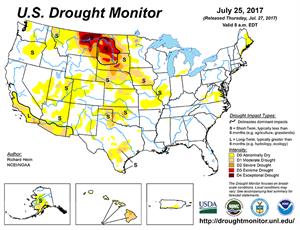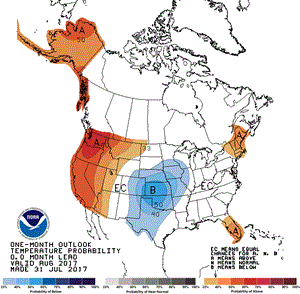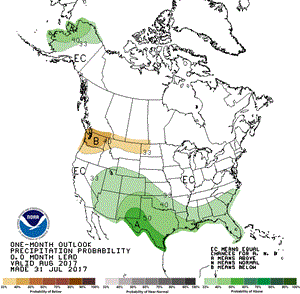USDA ratings of the 18-state corn crop have changed little in the past two weeks. Sixty-one percent of the crop is rated good/excellent, a three-point drop, and 13 percent poor/very poor, a two point increase.
South Dakota’s crop is another story. Thirty-nine percent is poor/very poor, up from 28 percent two weeks ago. The good/excellent rating slipped only 1 point, however, to 29 percent. FCSAmerica crop insurance experts characterize the western part of South Dakota as being “in very tough shape,” while the eastern part of the state is so dry that corn silage will be chopped for some economic gain.
“Producers will want to talk with their crop insurance agent, agronomist and lender when making the decision to chop their corn,” said Tyler Leighton, FCSAmerica crop insurance officer based in Mitchell, South Dakota. “The crop will need to be appraised before they start.”
Producers also a guaranteed market for their silage if they are unable to feed it themselves, Leighton added.
Corn in the other states in FCSAmerica territory also worsened due to the heat, but on a much smaller scale. Below are the USDA ratings for states served by FCSAmerica and Frontier Farm Credit:
CORN | Poor/very poor (percent), 7/30 | Poor/very poor (percent), 7/18 | Good/excellent (percent), 7/30 | Good/excellent (percent), 7/18 |
18 states | 13 | 11 | 65 | 64 |
Iowa | 10 | 6 | 56 | 71 |
Kansas | 13 | 10 | 61 | 59 |
Nebraska | 14 | 12 | 29 | 65 |
South Dakota | 39 | 28 | 29 | 30 |
Eighty-five percent of the corn crop in the 18 states is silking, right on average, and 23 percent has reached the dough stage, two points behind average.
Soybean progress in the 18 states actually is ahead of average: Blooming, 82 percent vs. 80 percent average; pod setting, 48 vs. 45 average.
Again, South Dakota stands out as a trouble spot:
SOYBEANS | Poor/very poor (percent), 7/30 | Poor/very poor (percent), 7/18 | Good/excellent (percent), 7/30 | Good/excellent (percent), 7/18 |
18 states | 13 | 11 | 59 | 61 |
Iowa | 12 | 10 | 60 | 63 |
Kansas | 8 | 6 | 51 | 59 |
Nebraska | 13 | 12 | 60 | 63 |
South Dakota | 35 | 33 | 28 | 29 |
Pasture and Range
Cows are moving off some of the dried up pastures in the northern Plains. USDA rates South Dakota’s pastures and range 71 percent poor/very poor; North Dakota, 78 percent and Montana 60 percent. Nebraska’s now are 53 percent poor/very poor. Kansas, by comparison, has 9 percent in the low range and 59 percent good/excellent. We could see enough calves move off pasture early to dampen the calf and feeder market and fill feedlots earlier than expected.
Weather prospects
The long-term drought monitor map shows the drought intensifying in the northern Plains and spreading through Nebraska and Iowa.

Map Source: http://droughtmonitor.unl.edu/
Meanwhile, the Climate Prediction Center foresees cooler-than-average August temperatures in the Central Plains/Western Corn Belt, providing relief to crops and livestock. It also forecasts equal chances of above or below normal rainfall.


Maps Source: http://www.cpc.ncep.noaa.gov/products/predictions/30day/

